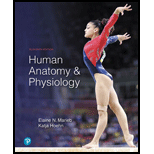
To analyze:
The following atoms 6C12, 6C13, and 6C14, and:
1. State the similarity in all of them.
2. The difference between them.
3. The definition for these groups of elements.
4. The atomic configuration of 6C12 showing relative positions and numbers of the subatomic particle by using the planetary model.
Introduction:
Atom is the smallest unit of any particle. When two elements combine with each other, the formation of molecules occurs. Molecules combine to form a molecular compound. An element is designated with the atomic number and atomic mass. An atomic number of an element is the number of protons of the element. Atomic mass can be defined as the summation of thenumber of protons as well as the neutrons present in the nucleus of the atom of the element.
Want to see the full answer?
Check out a sample textbook solution
Chapter 2 Solutions
Human Anatomy & Physiology (11th Edition)
- Elemental analysis of a compound with molar mass 342.3 g/mol gives the following mass percent composition: C 42.11%, H 6.48%, O 51.41%. Find the molecular formula of the compound. Enter your answer in the space below using the following format: if the molecular formula of a compound containing elements X, Y, and Z is X2YZ3 enter your answer as X2YZ3.arrow_forwardCalculate the coulomb energy for the following three nuclei using the semi-empirical mass formula. a) 19F b) 48Tİ c) 63Cuarrow_forwardWhich of the following elements would you expect to form (i) diatomic molecules, (ii) mainly covalent bonds, (iii) mainly ionic bonds, and (iv) both covalent and ionic bonds? (More than one answer may apply; rememberthat some nonmetals can form ionic bonds with metals.) Explain your answers.arrow_forward
- According to chemist John Dalton, if one mole of nitrogen is combined with three moles of hydrogen to form one mole of ammonia (knowing that nitrogen, with an atomic number of 7, has an atomic mass of 14, and hydrogen, with an atomic number of 1, has an atomic mass of 1), then this compound will have an atomic weight (or molecular mass) of: 14 grams per mole (14 daltons) 17 grams per mole (17 daltons) 20 grams per mole (20 daltons) 22 grams per mole (22 daltons) 43 grams per mole (43 daltons)arrow_forwardComplete the table below, using the diagram of an atom shown at right. name symbol 0 proton e Properties of subatomic particles charge (in multiples of e) 0 0 0 approximate mass (amu) (choose one) ✓ (choose one) ✓ 1.0 location on diagram (choose one) ✓ (choose one) ✓ A X A Sarrow_forwardIodine has 37 known isotopes. Therefore, the atomic mass has a range of 108-144 amu. Which of the following statements concerning iodine is correct? A) The isotopes of iodine have between 55 and 91 protons. B) An atom of iodine can have between 55 and 91 neutrons. C) The isotopes of iodine will always have the same number of neutrons, but the protons can vary. D) The isotopes of iodine have between 108 and 144 neutrons, but the number of protons will not vary.arrow_forward
- . Give the name of and symbol for an element with this number of valence electrons.a) 2b) 6c) 8arrow_forwardOxygen has 8 protons, 8 neutrons, and 8 electrons. What is its atomic mass?(a) 8 (b) 16 (c) 24 (d) 32.arrow_forwardHow many electrons are in the outer shell of each of the following atoms?arrow_forward
- Chlorine is an element with the symbol Cl. Draw and label atomic structure of chlorine indicating the number and locations of protons, neutrons and electrons in one atom of chlorine.arrow_forward(a) A homogeneous mixture which contains water as a solvent is called (b) Ni(CIO4)2-6H2O is hydrated whereas Ni(CIO.)e is (c) NaCl contains an bond whereas O2(g) contains a bond (d) A homogeneous mixture has a and composition (e) Temperature is an because it does not depend on the amount of substance (f) The maximum number of electrons that an orbital can have is (9) The energy of the lowest level in the H atom is (h) Arrange the following subshells in the H atom in order of increasing energy: 3s 4d 2р 4f 3d 2s 3p () Wavelength and frequency of radiation have an relationshiparrow_forwardThe empirical formula of the sugar glucose is C6H12O6. (a) How many moles are there in 270 g of glucose? (b) Calculate the molarity of a solution of 324 g of glucose dissolved in 2.0 l of water.arrow_forward
 Principles Of Radiographic Imaging: An Art And A ...Health & NutritionISBN:9781337711067Author:Richard R. Carlton, Arlene M. Adler, Vesna BalacPublisher:Cengage Learning
Principles Of Radiographic Imaging: An Art And A ...Health & NutritionISBN:9781337711067Author:Richard R. Carlton, Arlene M. Adler, Vesna BalacPublisher:Cengage Learning
